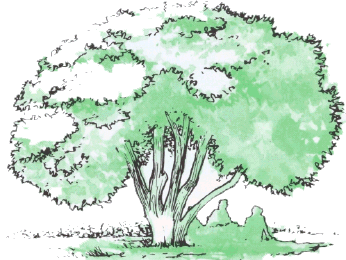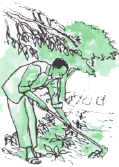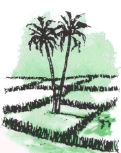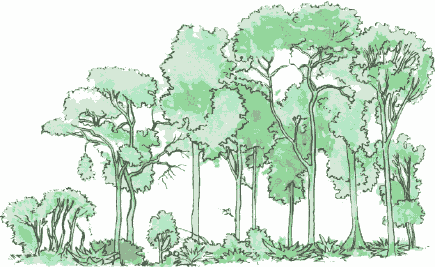



Trees planted near agricultural land offer many environmental benefits: they provide simile, reduce erosion, increase soil fertility, lower water tables, lessen the risks of salinization, and help stabilize water supplies.
Forests and trees make an essential contribution to food security by helping to maintain the environmental conditions needed for agricultural production. They stabilize the soil, prevent erosion, enhance the land's capacity to store water, and moderate air and soil temperatures.
The importance of these effects has often been ignored in the past, with the clearance of tree vegetation and the subsequent loss of millions of hectares of productive land. Furthermore, as forests continue to be cleared-exposing the land to direct attack from wind and rain-soil erosion and land degradation are still undermining agriculture's resource base.
On the vast flood plains of the Indian subcontinent, floods which formerly occurred once every ten years now come every year. The 15 million people living on the densely-rivered delta of Bangladesh will face worse flooding in the future because sediment from floods is filling the river basins and thus extending the spread of future flooding.
Much of the increased flooding in lowland areas has been attributed to the continued felling of the Himalayan forest-the rhododendron forests in the Himalayas are expected to disappear within 30 years. Though far from Bangladesh, it is in this mountainous region that the rivers rise which eventually flow down to the plains of the Indian subcontinent. The destruction of forests upstream affects the flow of these rivers and the amount of sediment they carry, and therefore increases the magnitude of flooding downstream.
The rate at which soil erosion occurs depends critically on the land's vegetative cover. Remove it, and the soil begins to crumble: bare soil offers no protection against the ravages of wind and rain. The ground cover and litter layer beneath the forest canopy are perhaps the best protection there is against erosion, and are even more important than trees themselves in preventing erosion. Erosion beneath teak plantations in Trinidad, for example, was traced to a lack of understorey vegetation and surface litter.
Studies have shown that the more closely an agricultural system resembles a natural forest in its canopy structure, tree spacing and ground cover, the less chance there is of soil erosion. Traditional agroforestry techniques, which provide natural cover, have been used for centuries to produce food without causing long-term damage to the environment.

Agroforestry systems improve soil fertility and reduce soil erosion.
Food producers in Amazonian Ecuador, for example, combine a system of trees, ground cover and livestock grazing that maintains the soil's stability and rapidly improves the soil during the fallow period. Such agroforestry techniques are now being used in many countries to increase food production, check soil erosion and reduce flooding.
Soil erosion leads directly to an increase in the amount of sediment in rivers. The effects are both harmful and costly, as sediment buries crops, clogs fish gills, damages marine fisheries, seagrass beds and coral reefs, impairs drinking water quality, reduces the capacity of irrigation reservoirs and clogs irrigation canals. Sediment also fills flood control dams, leading to a vicious circle in which the effects of one year's floods guarantee worse flooding in subsequent years.
The reforestation of erosion-prone areas can prevent these disastrous effects. In parts of Indonesia, reforestation has reduced sedimentation rates in downstream valleys by as much as two-thirds.
Trees are also being used in both developed and developing countries as windbreaks to shelter crops, prevent erosion and protect the soil. Trees reduce wind speeds, thus protecting crops, water sources, soils and settlements, and enhancing agricultural yields.
In arid and semi-arid parts of the world trees are used to slow down the expansion of the deserts and stabilize sand dunes so that crops can be grown. In Chad and Niger, wide expanses of crop land are now protected from desertification by multi-species shelter belts.
As well as offering protection from the ravages of the wind, shelter belts protect crops from grazing animals and provide a source of fuelwood, food and fodder-scarce commodities in many arid and semi-arid regions. The belts also reduce the rate of water lost by the crops through evapotranspiration. As a result, the crops need less water.
In coastal areas, trees planted as salt breaks can allow cropping nearer to the sea. Such salt breaks also offer protection against wave damage during storms, and reduce the chances of flooding and physical damage to inland areas from tide surges.

In arid and semi-arid regions, shelter belts slow down the rate of desertification and provide suitable conditions for crops.
The establishment of woody perennials and nitrogen-fixing trees close to, or intercropped with, agricultural crops maintains or improves the fertility of arable land. Trees increase the soil's ability to absorb and retain water, produce nutrients for plants, maintain high levels of organic matter in the soil, and moderate soil temperatures.
Shifting cultivators and other farmers who depend on forest-fallow systems have long recognized the vital role that trees play in maintaining soil fertility. Traditional agroforestry techniques play a significant role in increasing household food security in many countries. In Nigeria, for example, the planting of alternate rows of Leucaena leucocephala with maize and cowpeas has resulted in a marked improvement in soil fertility.
Agroforestry also helps reduce the risk of soil salinization, now increasingly common in arid and semi-arid regions. This trend is threatening land productivity, especially in irrigated areas. Waterlogged soil becomes saline as water is repeatedly evaporated from its surface, leaving salts behind and concentrating them near the soil surface. By increasing the soil's ability to absorb water and lowering the water table, trees reduce the risks of waterlogging and salinization. Planting trees in regions where soil salinity has ruined the land's productive capacity has, in some instances, reduced salinity sufficiently to return formerly barren land to productivity.
A growing feature of much of today's agricultural land is compacted soil-the result of poor logging or agricultural practices. When soil is compacted, water cannot seep into its lower levels, groundwater levels fall, and wells and springs dry up. Planting trees on land that is badly compacted may help break up the soil structure and so improve the rate at which rainfall infiltrates the soil.
As forests are cleared and the land becomes increasingly degraded through misuse, water supplies suffer. In an environment with vegetative cover, the soil acts like a gigantic sponge, storing a vast quantity of water that is used by plants and trees or released gently into streams and rivers. Degradation limits the storage capacity of this sponge, leading to water shortages during dry seasons and, in wet seasons, to brief destructive floods, during which very little water is absorbed by the soil.
This is why large areas of formerly productive land, where annual rainfall is relatively high, have become desertified once tree cover is removed.
Forests can also enhance water quality in other ways. Studies in Nigeria, Indonesia and other countries have shown that, when the forest is removed, minerals and nutrients that trees absorb or recycle make their way, unchecked, into drainage water. Apart from the disadvantage of losing minerals and nutrients from the immediate area, the extra nutrients in the water enhance the growth of oxygen-depleting organisms on canal and river beds, and reduce the overall value of the water for irrigation purposes.
Forest buffer zones around lakes and streams act as a filtering system, reducing the amount of sediment, agricultural chemicals and pesticides in the watercourses. The loss of this filtering system results in high levels of sediment and dissolved minerals in rivers and streams which reduce crop growth and disrupt fisheries.
Increased reforestation on unstable land, and around lakes, rivers and streams can thus help to increase the water-retention capacity of land and improve water quality, both of which benefit food production.
Trees also exert a substantial influence on both local microclimates and, possibly, on global climate. Trees affect temperature, humidity, moisture availability and light conditions in their immediate vicinity. The success of many agroforestry systems depends in part on the trees' capacity to moderate soil and air temperatures, and to increase relative humidity-two factors important for improved crop growth.
Recent research also suggests that forests may have an effect on climate through their influence on rainfall patterns, surface reflectivity and other meteorological variables. One reason is the change in the way sunlight is reflected from the earth's surface when forests are destroyed. In a living forest, sunlight is absorbed by leaves, branches and tree trunks. When the forest is destroyed, reflectivity is increased, and the land absorbs less heat. Atmospheric circulation and rainfall patterns are then significantly altered. Furthermore, in deforested areas, much less solar energy is used to evaporate moisture from the leaves of plants and trees. This leads to further climatic changes, and tends to increase temperatures during the day time and lower those at night.
Forests are also an important cog in the carbon cycle. Forests that are cut down and burned release their carbon into the atmosphere, adding to the concentration of atmospheric carbon dioxide which is one of the major contributors to the global warming caused by the greenhouse effect.
Living forests play the opposite role, removing carbon dioxide from the atmosphere. Large-scale reforestation has been suggested as one important way to help reduce the expected global warming. But afforestation would have to be carried out on a continental scale if it were to achieve substantial reductions in quantities of carbon dioxide in the atmosphere.

The clearance of natural forests is threatening the productivity of millions of hectares of land.